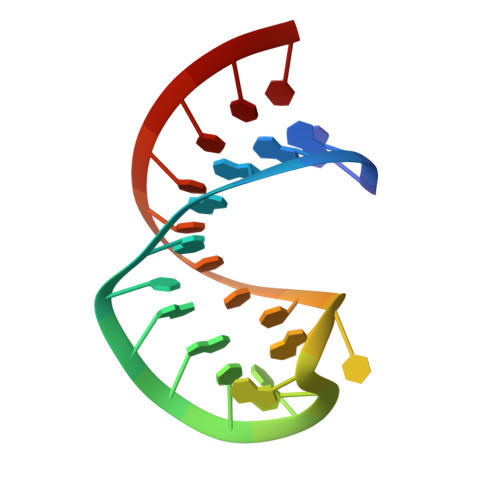Solution structure of the pseudo-5' splice site of a retroviral splicing suppressor.
Cabello-Villegas, J., Giles, K.E., Soto, A.M., Yu, P., Mougin, A., Beemon, K.L., Wang, Y.X.(2004) RNA 10: 1388-1398
- PubMed: 15317975
- DOI: https://doi.org/10.1261/rna.7020804
- Primary Citation of Related Structures:
1S2F, 1S34 - PubMed Abstract:
Control of Rous sarcoma virus RNA splicing depends in part on the interaction of U1 and U11 snRNPs with an intronic RNA element called the negative regulator of splicing (NRS). A 23mer RNA hairpin (NRS23) of the NRS directly binds U1 and U11 snRNPs. Mutations that disrupt base-pairing between the loop of NRS23 and U1 snRNA abolish its negative control of splicing. We have determined the solution structure of NRS23 using NOEs, torsion angles, and residual dipolar couplings that were extracted from multidimensional heteronuclear NMR spectra. Our structure showed that the 6-bp stem of NRS23 adopts a nearly A-form duplex conformation. The loop, which consists of 11 residues according to secondary structure probing, was in a closed conformation. U913, the first residue in the loop, was bulged out or dynamic, and loop residues G914-C923, G915-U922, and U916-A921 were base-paired. The remaining UUGU tetraloop sequence did not adopt a stable structure and appears flexible in solution. This tetraloop differs from the well-known classes of tetraloops (GNRA, CUYG, UNCG) in terms of its stability, structure, and function. Deletion of the bulged U913, which is not complementary to U1 snRNA, increased the melting temperature of the RNA hairpin. This hyperstable hairpin exhibited a significant decrease in binding to U1 snRNP. Thus, the structure of the NRS RNA, as well as its sequence, is important for interaction with U1 snRNP and for splicing suppression.
Organizational Affiliation:
Protein-Nucleic Acid Interaction Section, Structural Biophysics Laboratory, CCR, National Cancer Institute-Frederick, National Institutes of Health, MD 21702, USA.














